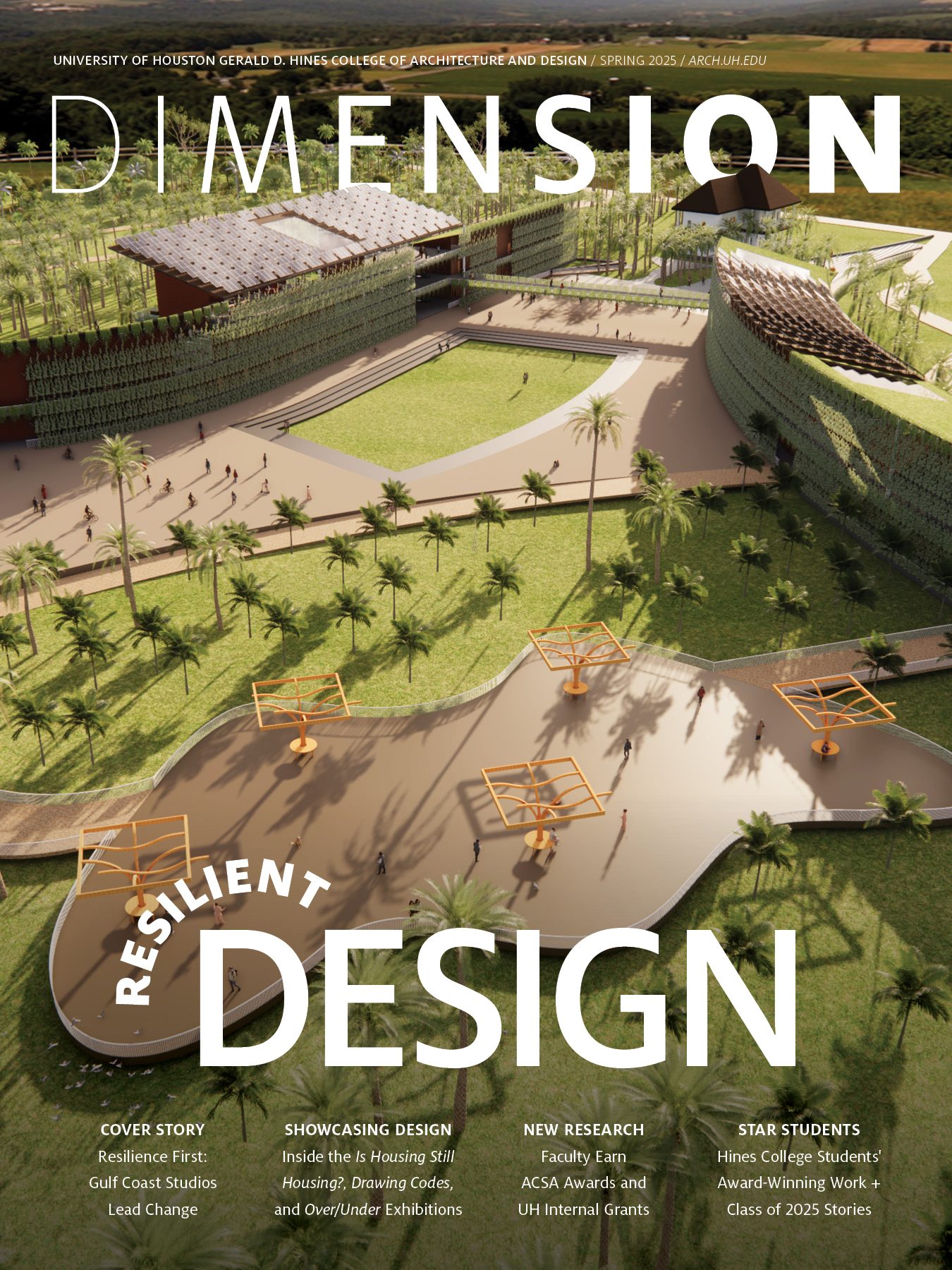Resilient by Design: A New Blueprint for Urban Futures
The Hines College’s QuadZero Studio is training the next generation of climate-conscious architects and designers
by Nicholas Nguyen • May 29, 2025
above: Students present their work in spring 2023's QuadZero Brownfields to Brightfields jury that included community members and leaders
Each year, cities experience the devasting effects of climate change, whether through rising sea levels, searing heat, or destructive storms. As a result, architects and designers find themselves not only reshaping skylines but also rewriting the rules of resilience. Few places embody these challenges and the opportunity to reimagine the built environment, like Houston.
In architecture, resiliency refers to how buildings, neighborhoods, and infrastructure withstand environmental, social, and economic stressors. This includes preparing for threats like floods, extreme heat, storms, and power outages. Resilient design goes beyond durability, adaptability, and recovery. It also integrates sustainable strategies that reduce energy use, conserve water, minimize waste, and promote equity.
At the University of Houston’s Gerald D. Hines College of Architecture and Design, the QuadZero Studio is preparing students to do just that. Founded in 2016 by Hines College architecture professor Dr. Bruce Race, FAIA, FAICP, the studio has become a crucible for exploring what it truly means to design resilient cities. The name reflects the studio’s core mission: zero greenhouse gas emissions, zero energy waste, zero water waste, and zero landfill waste. But this is more than just a sustainability slogan; they are values rooted in lived experience.
“Houston is where our students want to live and work. The city needs them, and they need to be ready.”
“Our students are entering a profession that must be at the middle of the table to design projects mitigating their climate impact and adapting to risks from severe weather events,” Dr. Race explained. “They have lived through floods, freezes, and blackouts. These are not abstract problems. They are personal.”
Indeed, Houston’s extremes make it a natural testbed. According to Dr. Race’s research as the director of the Hines College’s Center for Sustainability and Research (CeSAR), the city suffers from heat island effects that are twice the national average, and median-income families here pay double the national energy bills. These realities, he says, create patterns of energy poverty and exacerbate other systemic inequities in food access, childcare, and healthcare. In this context, architecture is not just about buildings — it is about the far-reaching consequences of climate change.
A Studio Born from Climate Crisis
QuadZero was launched in response to climate science and the urgent needs of Houston communities. From the start, the studio emphasized design grounded in research, data, and real-world collaboration.
“Houston is where our students want to live and work. The city needs them, and they need to be ready,” Dr. Race said.
And ready they are. Over nearly a decade, the QuadZero studio has tackled some of Houston’s most complex challenges, from post-disaster recovery to urban growth designed to face the future. In 2018, the studios responded to Hurricane Harvey’s devastation by focusing on the Brays Bayou Watershed, which led to funding from the Jewish Federation for community planning in the watershed and collaboration with community stakeholders to find solutions for flooding in Keegans Bayou. The closed Ruffino Hills Landfill became the focus for that solution. That plan earned an American Planning Association (APA) Gold Resilience Award from Houston and Texas APA chapters.
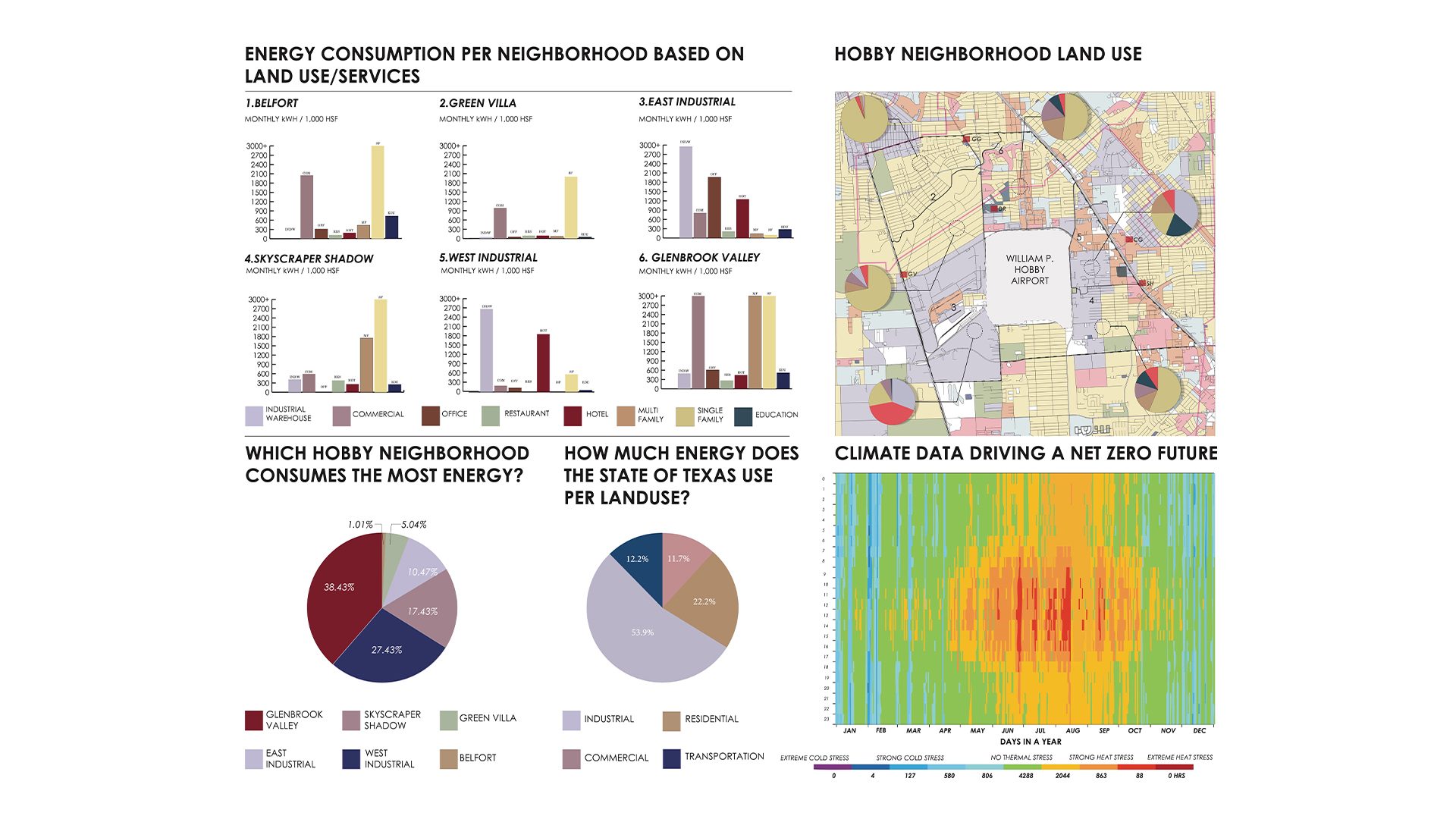
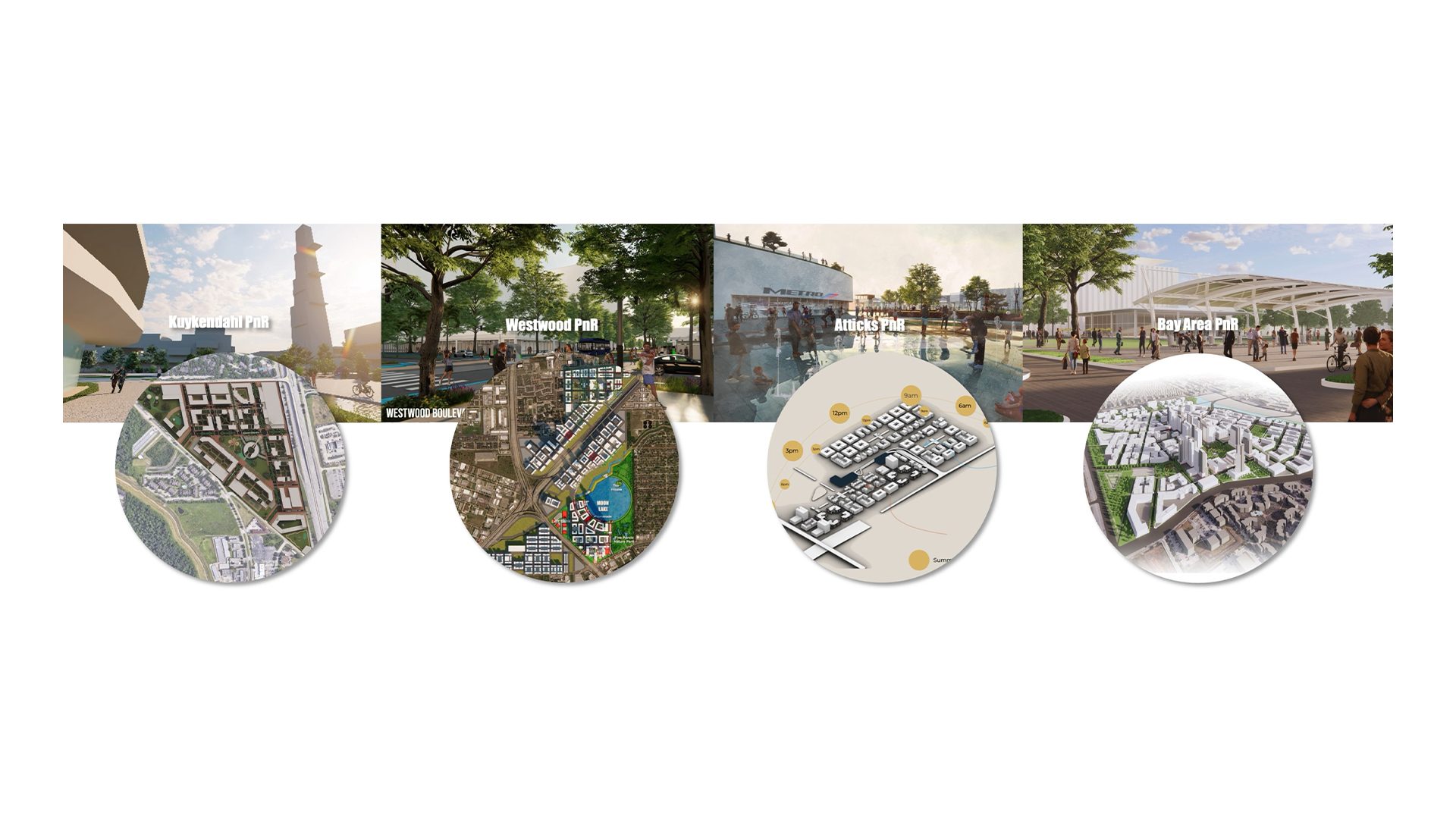

above: A graphic from the QuadZero Aviation City studio that shows energy use baseline by neighborhood and land use by My-Lien Dang, Alberto Delgado, Diego Iniguez, Jessica Sandoval Ospina, and Cynthia Ulloa; A graphic from the Regional System Of Resilience Hub TODs: METRO Park and Ride Sites by the students in the fall 2022 QuadZero studio; A presentation board from the Brownfields to Brightfields: Equitable Net Zero Sunnyside project showing data about infrastructure, populations, green spaces, and more by Ivy Farhadi, Esmer Leija, Minh Nguyen, and team
Reimagining the Urban Fabric for the Future
Recently, students have turned their attention to Houston’s rapid expansion — an expected 2 million additional residents by 2050. Between 2022 and 2023, a three-semester arc called “Housing the Next 2 Million” asked students to look at the hidden potential of urban infra-structure already in place instead of undeveloped land.
During fall 2022, the studio explored how 30 METRO Park and Ride sites could become mixed-use Transit Oriented Developments (TODs) serving as resilience hubs. METRO sponsored the studio, linking it with a National Science Foundation grant on smart transit.
Then, the spring 2023 semester brought a shift in lens with “Brownfields to Brightfields.” Students inventoried 63 closed landfill sites and reimagined four of them as infill development anchored by clean energy. A collaboration with the City of Houston and UH Energy, the project’s findings were later included in an EPA grant proposal.
In fall 2023, the focus shifted to the hollowing out of retail centers. “Dead Mall Fall” invited students to redesign ten abandoned shopping malls as future community anchors. One group focused on the Northwest Mall, now eyed as the site of a high-speed rail terminal, envisioning a town center for 64,000 new residents. These adaptive reuse strategies underscore the studio’s central tenet: climate resiliency must go together with smart urbanism.
In spring 2024, students partnered with the Houston Land Bank and North Central Houston Management District to propose site-specific solutions for the former Yellow Cab Company site. Their ideas included net-zero housing, energy production, and the reuse of old industrial infrastructure.
“Students learn how to analyze urban and natural systems and communicate their findings. They use data to demonstrate how to reduce environmental impacts and support new and existing communities with renewable energy and recycled water and waste.”
Students in the QuadZero studio combined their talents under the moniker “Team Jellyfish” and won the inaugural “Power the Community” International College Design Competition, earning a $7,000 prize for “Distinguished Design – Urban Planning” from the Energy Mentors organization. Team Jellyfish developed concepts for a net-zero neighborhood fueled by emerging biofuel technology in Houston’s Near Northside Community. They began in two stages, first focusing on renewable energy, transportation, and net-zero practices on an urban scale. Then, they designed individual projects to further their energy narrative.
“QUAD Zero students participate in a two-part semester split between urban-scale analysis and developing a building design inside their net zero master plan,” Dr. Race explained. “Students learn how to analyze urban and natural systems and communicate their findings. They use data to demonstrate how to reduce environmental impacts and support new and existing communities with renewable energy and recycled water and waste.”
The impact of QuadZero’s projects is amplified through partnerships with organizations like METRO, the City of Houston, Harris County Flood Control District, Habitat for Humanity, and community development corporations. Collaborators often sponsor semesters, attend juries and reviews, and fund publication of student work, ensuring a reciprocal relationship between the studio and the people it aims to serve.
above: A rendering from the Northwest Mall project in the QuadZero studio's "Dead Mall Fall" theme in fall 2023 by Jesus Gonzalez, Robert Perla, Jaquelyn Ramos-Caceres, Daniel Russel, Vincent Taylor, and team; Team Jellyfish's award-winning project — by Yen Co, Yulisa Tran, Lucia Poggioli, Jailyn Benavides, Leslie Alamirra, and Lauren Smith — proposed energy solutions for Houston's Near Northside neighborhood; A rendering from Carlos Sierra's project, Global Gateway Transformation for Hobby Airport, from spring 2025's "Aviation City" studio
Including Transportation and Green Spaces as a Resilience Strategy
Recent projects have also focused on the role of transportation in reshaping cities. In fall 2024, students designed TODs along Lockwood Street in Houston’s East End, exploring how nodes like Harrisburg and Navigation Boulevard could transform into sustainable mixed-use corridors.
This spring, the focus turned skyward. The “Aviation City” studio worked with the Houston Airport Authority to plan a vision for 2050 for areas surrounding Hobby Airport. Students envisioned a regional intermodal hub that connects light rail, buses, shuttles, rideshare, and even vertical taxis.
“These students are defining how we rethink movement in a city built for cars,” Race says. “They are showing how multimodal transit can support walkable, inclusive development.”
In fall 2025, the studio will once again expand its definition of infrastructure by looking at parks. The question: How can green spaces be leveraged for energy, hydrology, real estate, and recreation? Students will design net-zero infill developments with parks as their anchors, highlighting how open space can do more than beautify; open space can stabilize neighborhoods, absorb stormwater, and even generate energy.
A Legacy of Impact
For Dr. Race, the long-term goal is not just to teach sustainable design, but to institutionalize it. He envisions former students eventually taking the reins.
With 19 studios behind them and a growing network of alumni, the QuadZero model offers a compelling blueprint for resiliency in design. “They have a lot of work to do — saving the planet requires a career-long commitment. By 2050, they will be 25 years younger than I am now,” he added.
Ultimately, QuadZero is not just teaching design; the studio teaches environmental responsibility. Dr. Race and his students are demonstrating that the future of architecture must be grounded in equity, resilience, and climate action. And in Houston, where disasters are frequent and growth is relentless, that future cannot come soon enough.
Get the Scoop
This story was first published in the spring 2025 issue of DIMENSION Magazine.
Read the magazine.
More Hines College Stories
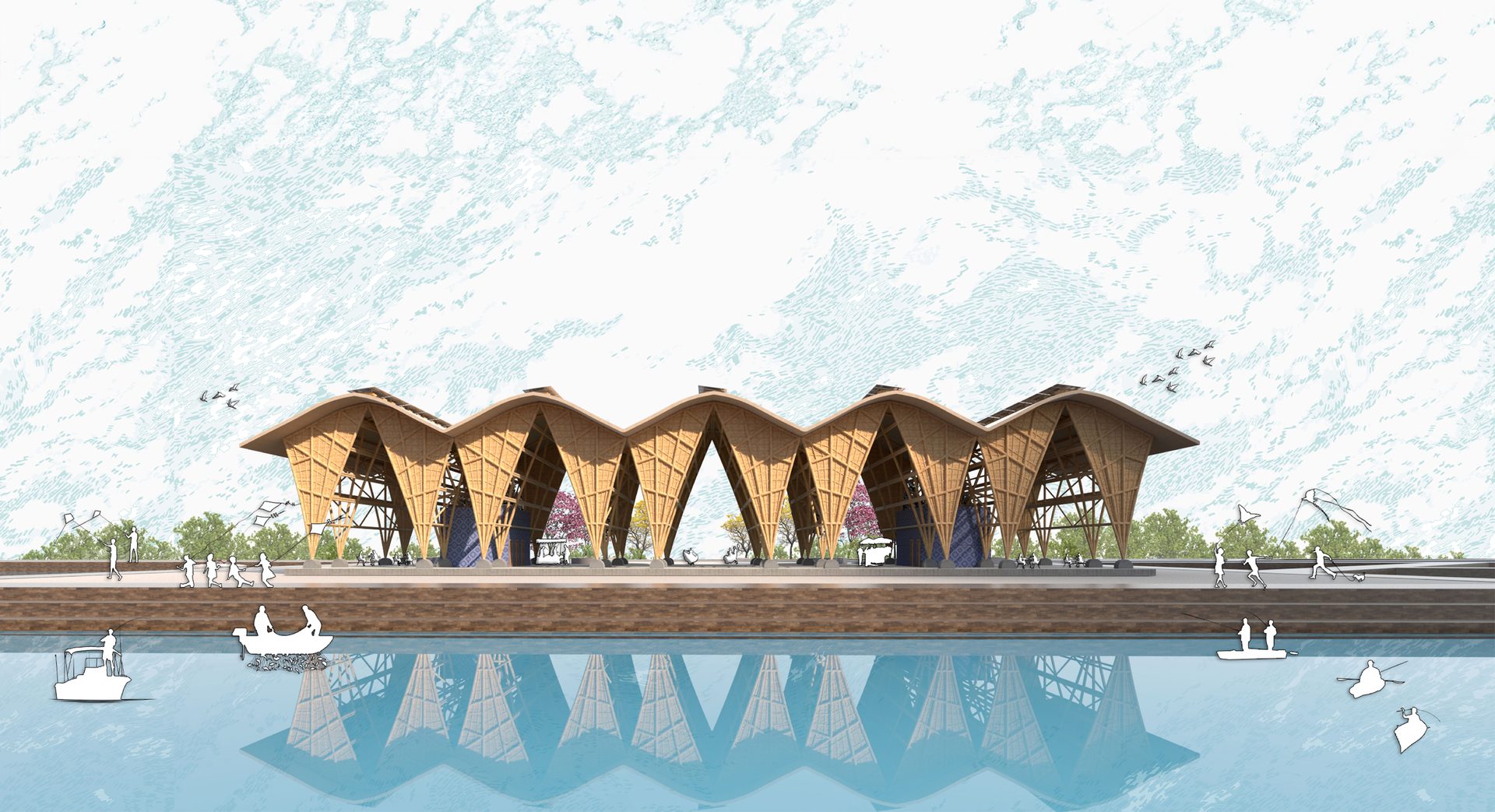
The Hines College continues to shape the future of the Gulf Coast through its investigative Gulf Futures studios, supported by a major grant from the National Academies of Sciences, Engineering, and Medicine (NASEM). Awarded to advance community resilience and adaptation strategies along the Gulf Coast, the grant has catalyzed groundbreaking work by faculty and students, focusing on climate-responsive design, environmental justice, and sustainable infrastructure.

On May 8, the Hines College celebrated the Class of 2025 – 195 graduates whose academic experience is defined by resilience and adaptability. Many of these students started their academic journeys under unexpected circumstances at the height of the COVID-19 pandemic, emerging stronger and more prepared to tackle the demands of their future professional careers. As they close this transformative chapter, several graduates reflect on their unique experiences.
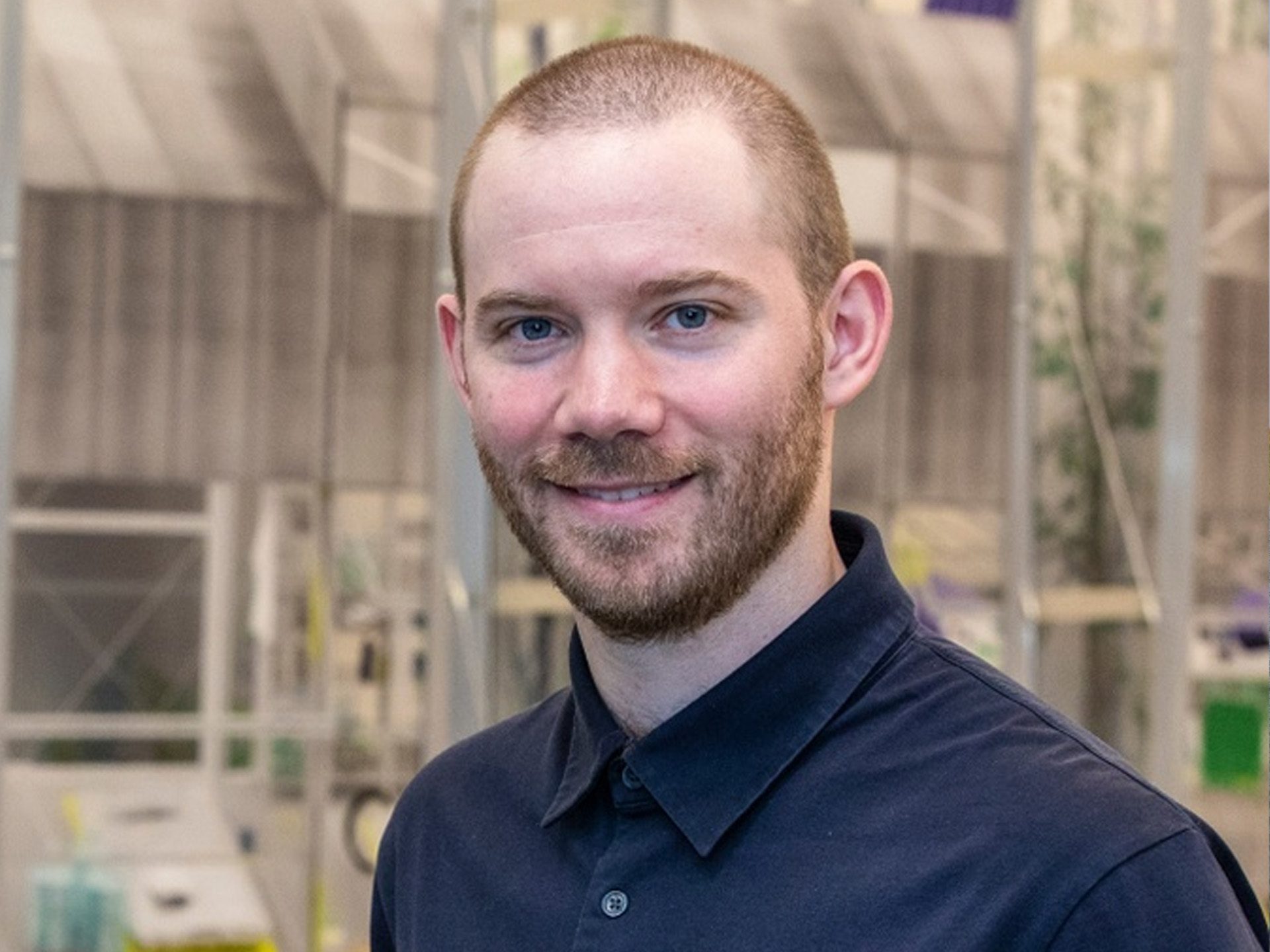
This spring, the Association of Collegiate Schools of Architecture (ACSA), in partnership with Columbia University’s Temple Hoyne Buell Center for the Study of American Architecture, named University of Houston Gerald D. Hines College of Architecture and Design instructional assistant professor Daniel Jacobs as a recipient of the prestigious 2025 Course Development Prize in Architecture, Climate Change, and Society.


